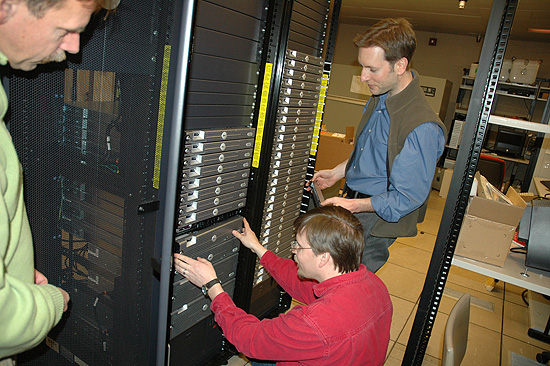New Computer Cluster Will Improve Research Campus-Wide
 |
| From left, Henk Meij, applications technology specialist; Francis Starr, assistant professor of physics; and James Taft, assistant director of technology support services, look over the newly-installed 10-terabyte computer cluster at Information Technology Services. |
| Posted 02/16/07 |
| It takes 10, 250-volt plugs to power up. It takes 9,000 BTUs to keep it cool. It can communicate 14 times faster than high-speed internet, and it has the potential to store more than 2.5 million MP3s.
But most important, this state-of-the-art high-performance computer cluster will offer both education and research opportunities for the university on a level which has never before been available. The cluster was installed this month, and will be connected to the entire Wesleyan network. This is going to change the way Wesleyan conducts research, explains Ganesan Ravishanker, associate vice president for Information Technology Services. This powerful computing cluster will offer advanced hardware and software resources for teaching strategies and research not specific to any one department or discipline. The high-performance cluster is made up of 288 central processing units from Dell, Inc. that work together as one machine. The unit has two functions it can either split one computational task across several different computers for a faster result, or it can process dozens of tasks at one time. Together, these units offer 10 terabytes of storage, equivalent to 10,000 gigabytes. A typical desktop computer has 150 gigabytes of disk space. It takes three to four terabytes to store all the information from the entire campus and this unit alone has 10, explains Henk Meij, applications technology specialist, who is overseeing the clusters operation.
In the past five years, four Wesleyan faculty set-up their own clusters. Of these, one is defunct, one is obsolete, and two are saturated and will soon be out of date. Starr, who is currently conducting research through this older, 80-unit cluster, will use the new cluster to benefit his own research on DNA-based nanomaterials and supercooled liquids. Since his work requires computer simulations that focus on molecular dynamics, the new cluster will drastically increase his ability for scientific computation. Now I will be able to get 288 answers in the time it would take to get one, Starr explains, while rotating a visualization of the molecular structure of water on his Mac. With the new hardware, Ill be able to explore the assembly of new molecular structures on a much larger scale, helping the development of nanomaterials with customized properties. And since the unit will be maintained by ITS, Starr looks forward to spending less time maintaining his current cluster and more time doing research and spending time with students. The cluster is a central resource so anyone can connect to it from their office or even home. Several Wesleyan faculty in the Natural Sciences and Mathematics have taken interest in the new computing unit, however it is not exclusive to NSM. Rex Pratt, the Beach Professor of Chemistry, can use the cluster to make models of small molecules that bind to enzymes. Eric Aaron, assistant professor of computer science, can further his research of tumor development and treatment, using massively computation-intensive geometric computation simulations. Mark Flory, assistant professor of molecular biology and biochemistry, carries out comparative searches of proteomic data with corresponding sequence databases. Cluster facilities will enable him to greatly expand his studies from small samples analyzed on a single workstation. Several other faculty researchers will immediately benefit as well. In addition to faculty use, undergraduate and graduate students will have opportunities to conduct research with these machines. There are already established extramurally-funded research programs at Wesleyan in theoretical astrophysics, liquid state chemical physics, nanotechnology, quantum chemistry, molecular biophysics, and the emerging field of neuroinformatics and structural bioinformatics, all of which depend on high-end computing to be competitive. Courses that involve computers are offered in each of these areas. Now, students are limited to the computers at their labs, Starr explains. We need to teach students how to get access to the cluster and take advantage of what it can offer. There is no end in sight for what we can do. The impacts of the new cluster can be seen at : http://www.wesleyan.edu/newsletter/campus/2007/0207cluster2.html |
| By Olivia Drake, The Wesleyan Connection editor |


 The cluster was funded by a $190,000 National Science Foundations Major Research Instrumentation Program grant, awarded in July 2006. The grant proposal was written by Francis Starr, assistant professor of physics; David Beveridge, the University Professor of the Sciences and Mathematics, professor of chemistry; and Katherine Johnston, formerly an assistant professor of astronomy. Each is involved in computationally-intensive research.
The cluster was funded by a $190,000 National Science Foundations Major Research Instrumentation Program grant, awarded in July 2006. The grant proposal was written by Francis Starr, assistant professor of physics; David Beveridge, the University Professor of the Sciences and Mathematics, professor of chemistry; and Katherine Johnston, formerly an assistant professor of astronomy. Each is involved in computationally-intensive research.